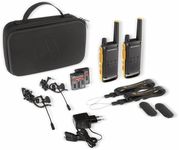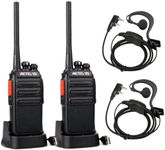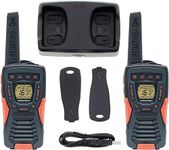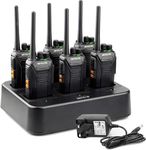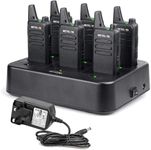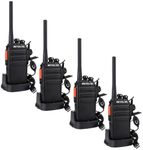Buying Guide for the Best Long Distance Walkie Talkies
When choosing long-distance walkie-talkies, it's important to consider the specific needs of your communication requirements. Whether you're using them for outdoor adventures, professional use, or emergency situations, understanding the key specifications will help you make an informed decision. The right walkie-talkie will ensure clear communication over the distances you need, with the features that suit your environment and usage patterns.RangeThe range of a walkie-talkie indicates the maximum distance over which it can communicate effectively. This is crucial because it determines how far apart users can be while still maintaining clear communication. Walkie-talkies are often advertised with a maximum range, but real-world conditions like terrain, buildings, and weather can reduce this range. Generally, ranges are divided into short (up to 2 miles), medium (2-5 miles), and long (5 miles and above). If you're using walkie-talkies in open areas like fields or mountains, a longer range is beneficial. For urban environments or indoor use, a shorter range might suffice.
Frequency BandWalkie-talkies operate on different frequency bands, primarily FRS (Family Radio Service) and GMRS (General Mobile Radio Service). FRS is suitable for short-range communication and doesn't require a license, making it ideal for casual use. GMRS offers longer range and more power but requires an FCC license in the U.S. If you need walkie-talkies for professional or extensive outdoor use, GMRS might be the better choice. For family outings or casual use, FRS is usually sufficient.
Battery LifeBattery life determines how long a walkie-talkie can operate before needing a recharge or battery replacement. This is important for ensuring continuous communication, especially during long trips or in emergency situations. Walkie-talkies can have rechargeable batteries or use standard AA/AAA batteries. If you plan to use them for extended periods without access to charging facilities, consider models with long battery life or the option to use disposable batteries. For regular, short-term use, rechargeable batteries might be more convenient.
Durability and Weather ResistanceDurability and weather resistance are key factors if you plan to use walkie-talkies in harsh environments. This includes resistance to water, dust, and impact. Look for models with an IP rating, which indicates the level of protection against these elements. For outdoor adventures or work in rugged conditions, a higher IP rating is advisable. If your use is primarily indoors or in mild conditions, a standard level of durability may be sufficient.
Channels and Privacy CodesChannels and privacy codes help manage communication and reduce interference from other users. Walkie-talkies come with multiple channels, allowing users to switch frequencies to avoid congestion. Privacy codes add an extra layer by filtering out unwanted transmissions on the same channel. If you're in a crowded area or need secure communication, more channels and privacy codes are beneficial. For less populated areas or casual use, fewer channels may be adequate.
Size and WeightThe size and weight of a walkie-talkie affect its portability and ease of use. This is important for comfort, especially if you need to carry the device for long periods. Compact and lightweight models are easier to handle and transport, making them ideal for hiking or travel. However, larger models might offer more features or better durability. Consider how and where you'll be using the walkie-talkie to determine the best balance between size, weight, and functionality.



